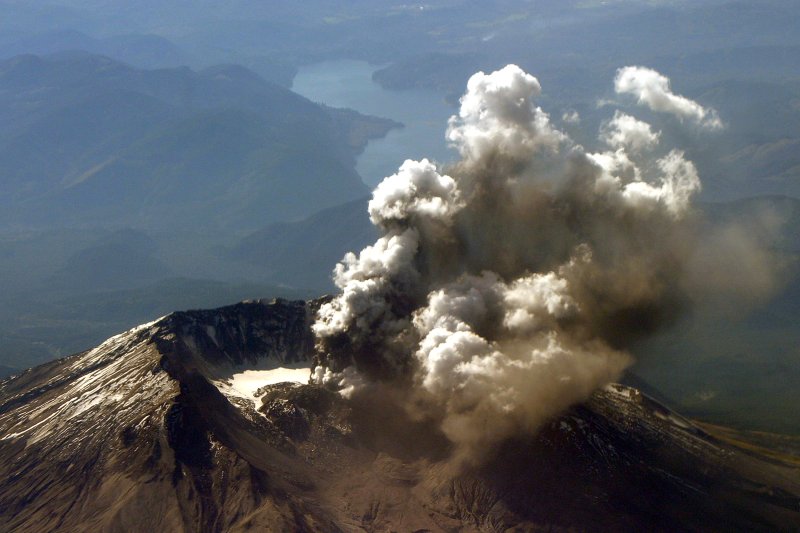Mount St. Helens emits a plume of steam and ash from an area of new crevasses in the crater glacier south of the 1980-86 lava dome on October 1, 2004. New research suggests the remnant of old volcanic rock and the crystals they contain could offer clues to the movement of magma prior to an eruption. Photo by UPI Photo/Scott Taylor/U.S. Navy |
License Photo
BRISTOL, England, June 30 (UPI) -- The movement of crystals in the magma of certain volcanoes may indicate the likelihood of an impending eruption.
New research by scientists at the University of Bristol suggests the movement of magmatic crystals might have predicted the eruption of Washington State's Mount St. Helens in 1980. Monitoring magmatic crystal movements, researchers say, may help volcanists predict future St. Helens eruptions, as well as eruptions at similar volcanoes.
Researchers presented their discovery at the Goldschmidt geochemistry conference, held this week in Yokohama, Japan.
"We looked for signs in the way zoned feldspar crystals grew and moved beneath Mount St. Helens in the build-up to the 1980 eruption," Jon Blundy, lead researcher and a professor at Bristol's School of Earth Sciences, said in a news release.
Crystals form delicate concentric layers in erupted volcanic rocks. Like the rings of a tree, they can offer information about the volcano's past. Their chemical composition can reveal the pressure and temperature at which the crystals formed in the magma chamber prior to eruption.
By analyzing the volcanic crystals, Bristol researchers developed a method for predicting how and when molten rock moved through the volcano's chambers before the eruption.
"Rapid upwards movement of magma at depths of several kilometers is a pretty good indication that something significant is happening," Blundy explained. "We have found a way of correlating the crystal composition to where they came from."
Researchers found that three years before the 1980 eruption -- which deposited ash in 11 states and killed 57 people -- magmatic crystals advanced from 12 kilometers below the volcano to just four kilometers below. Such a destabilization could be a strong sign that an eruption in the months or years to follow is likely.
"What we are doing is not a real-time monitoring, but a retrospective study of what happened prior to the last eruption," Blundy added. "Now we have found this movement, it's reasonable to assume that similar movement will precede any further eruptions from this and perhaps many other volcanoes."
Blundy and his research partners are now looking to see how their research may be applied to other, similar volcanoes. They're also hoping to find ways to use their research for improved monitoring techniques.
"Destabilization of deeply-stored magma and its ascent to shallow levels in the crust, may be one key factor, which may be especially useful in circumstances where we can monitor a volcano closely over a period of years," Blundy concluded.















